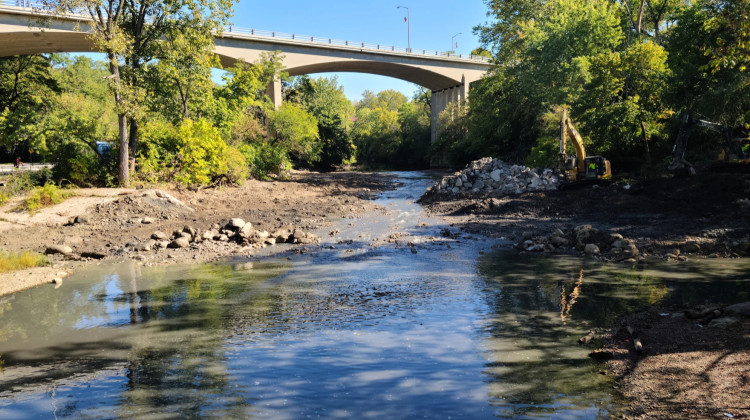
The Whitewater River now flows unencumbered through a breach where the Weir Dam stood for more than a hundred years.
Tana Weingartner / WVXUBy Tana Weingartner, WVXU
A long-standing low-head dam on the Whitewater River in Richmond, Ind., is no more. Crews are nearly finished removing the Weir Dam.
Construction sounds mingle with gurgling water as a pair of excavators remove chunks of concrete. The busted up rock and a pile of boulders are all that remain of the 110-year-old structure.
Across the river, people watch as the large yellow machines do their work. Some, like Norm Bartley, used to fish in the deep pool created at the base of the dam. He isn't happy to see the dam go, and worries about what removing it is doing to the ecosystem upstream, but, he concludes, it's probably best in the long run that the dam is coming out.
"That used to be a really swift, deep hole right there," he says, pointing to a spot just below the construction area where a bunch of boulders are stacked. It was one of the most popular fishing spots along this stretch of the Whitewater.
"Actually, it was kind of dangerous. It had a bad undertow."
He remembers fishing once with his 13-year-old nephew when the situation suddenly got scary. Bartley had dropped his fishing pole and his nephew jumped in to save it before Bartley could stop him.
"He was in before I knew what he was doing. I'd have stopped him; the fishing pole wasn't worth that. He got it back but he could have drowned."
Fortunately, the boy was OK, Bartley says.
Others haven't been so lucky. Deadly low-head dams are often referred to as "drowning machines." More than 1,400 people have died at them, according to the American Society of Civil Engineers.
"From 2010 to May 2020, the state of Indiana documented 25 deaths near or at low head dams, with at least 17 people injured and 50 rescued at dams of all types," the National Weather Service reports, adding there were two deaths in Indiana in 2021, too.

Jane and Jesse Bunker have also come to see how the work is going.
"It's been here all our lives and now they're taking it out. Things are changing," Jane Bunker says as she gazes across the river.
Her initial reaction, she says, was "Oh no!" Then she heard about the city's Whitewater Gorge Activation Plan, which includes — among other things — plans for canoeing and kayaking on the river.
"I thought, well, that might be kind of neat," she says.
"Yeah," chimes in her husband, Jesse. "If they have canoes going up and down there, that'd be pretty cool. Anything to try to revive Richmond a little bit."
Both Bunkers agree, taking out the dam is a "big job."
Phil Tevis, member-owner of FlatLand Resources, is the person responsible for pulling off that big job. He's a landscape architect and environmental designer who has spent years advocating for removing the dangerous dam across Indiana and Ohio. He spoke with WVXU's Tana Weingartner.
Weingartner: What was the dam's original purpose?
Tevis: The Weir Dam was installed in Richmond to be a water collection; it was a diversion for their city water and the city no longer uses that water supply. Once it is obsolete for its industrial purpose, then it poses a threat for either fish passage, which fish can't swim through, or people drown because they are recreation hazards. People get in the undertow and they drown, and/or you can't canoe or kayak very safely around them.
What is it about low head dams that makes them dangerous?
At a flood stage event or high flow event, the water circulating over the dam actually makes a reverse curve. If people that have, let's say, a life jacket on, because life jackets are dependent upon non air in the water, there's so much air in the water that then they get caught and pushed down under and they get trapped, usually on the bottom side of the dam and drown.
Tell me about the process of taking it out. How did you start?
Before the actual physical removal, we have to do a full survey of the area upstream to know where the sediment is and isn't. We have to also test the soil to make sure there are no contaminants that would be released that would cause harm to humans or the fish because when the water releases that sediment, it floats downstream. Once that's done, then we determine where on the dam all the way across is the best place to create a breach and then we try to draw down the breach so goes through the dam and laterally down. Once it's down far enough, it draws the water out and that allows us to begin to work on the rest of the dam.
How long is it going to take you to get this fully out of the way?
We will be done, probably, on Friday. We will have been here about 10 days.What's going to happen to all of the debris?
The concrete gets removed and goes to a dump site. The boulders that are here, those are the original dam. They are, from what we can tell, the original dam. There's archaeologists here that work with us to record everything so in the future people can refer back to what was here. The boulders are going to stay, the concrete is going to be removed and the sediment that's behind it is being shaped to the natural curvature of the channel, the stream. And when it starts to flood, that sand will start to push through and it will start to cleanse the river more like an open flowing stream.
What does taking the dam out do to the ecosystem above and below it?
The ecosystem immediately above has low oxygen (and) high temperatures, so the fish aren't as prevalent above the dam. That will change. Now there'll be more oxygen and more fish. Usually the first thing you see is darters, and then once you have darters, the small mouth come in afterwards.
On the downstream side, people say that it's a great fishery. The reality is it's one pool that's a fishery. If you look at the length, from here down about 1,000 feet, this area is starving in sand. If you don't have sand, then you don't have beds for the fish to spawn, so that sand that's upstream will equalize going through the system and what you end up with is a longer area of healthier habitat. It usually starts with the micro crustacean fish — you know, the little bugs — and then the clams and then eventually the darters, and so on and so forth up the food chain.
So people who have maybe been concerned — they see the dropping water levels above the stream as destroying the habitat — you're saying it's actually going to be better in the long run?
That is correct. It takes three to five years for the system to wash through. It depends upon how many high water events are here, but once the system blows through, there's data all across the world that shows the fisheries immediately respond and improve and then recreation usually comes shortly after that.
What do you think is the biggest misconception you've heard about taking out the dam?
Most people think we're lowering the water. The volume of water doesn't change whether it's there or not. That's probably the biggest misconception.
 DONATE
DONATE







 Support WFYI. We can't do it without you.
Support WFYI. We can't do it without you.